Assignment on What are the Basic Accounting Theories?
VerifiedAdded on 2022/09/23
|12
|2844
|121
Assignment
AI Summary
Contribute Materials
Your contribution can guide someone’s learning journey. Share your
documents today.
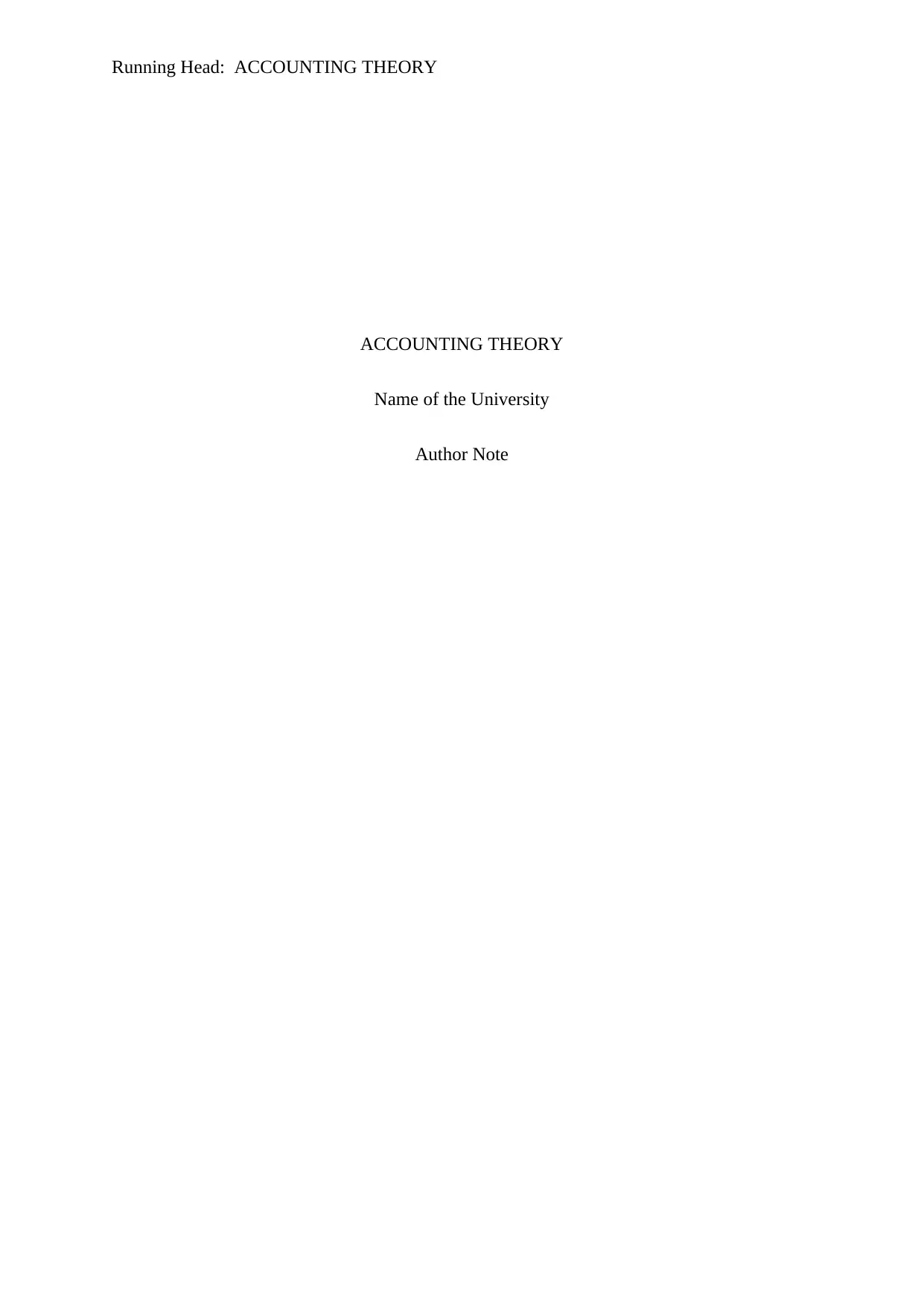
Running Head: ACCOUNTING THEORY
ACCOUNTING THEORY
Name of the University
Author Note
ACCOUNTING THEORY
Name of the University
Author Note
Secure Best Marks with AI Grader
Need help grading? Try our AI Grader for instant feedback on your assignments.
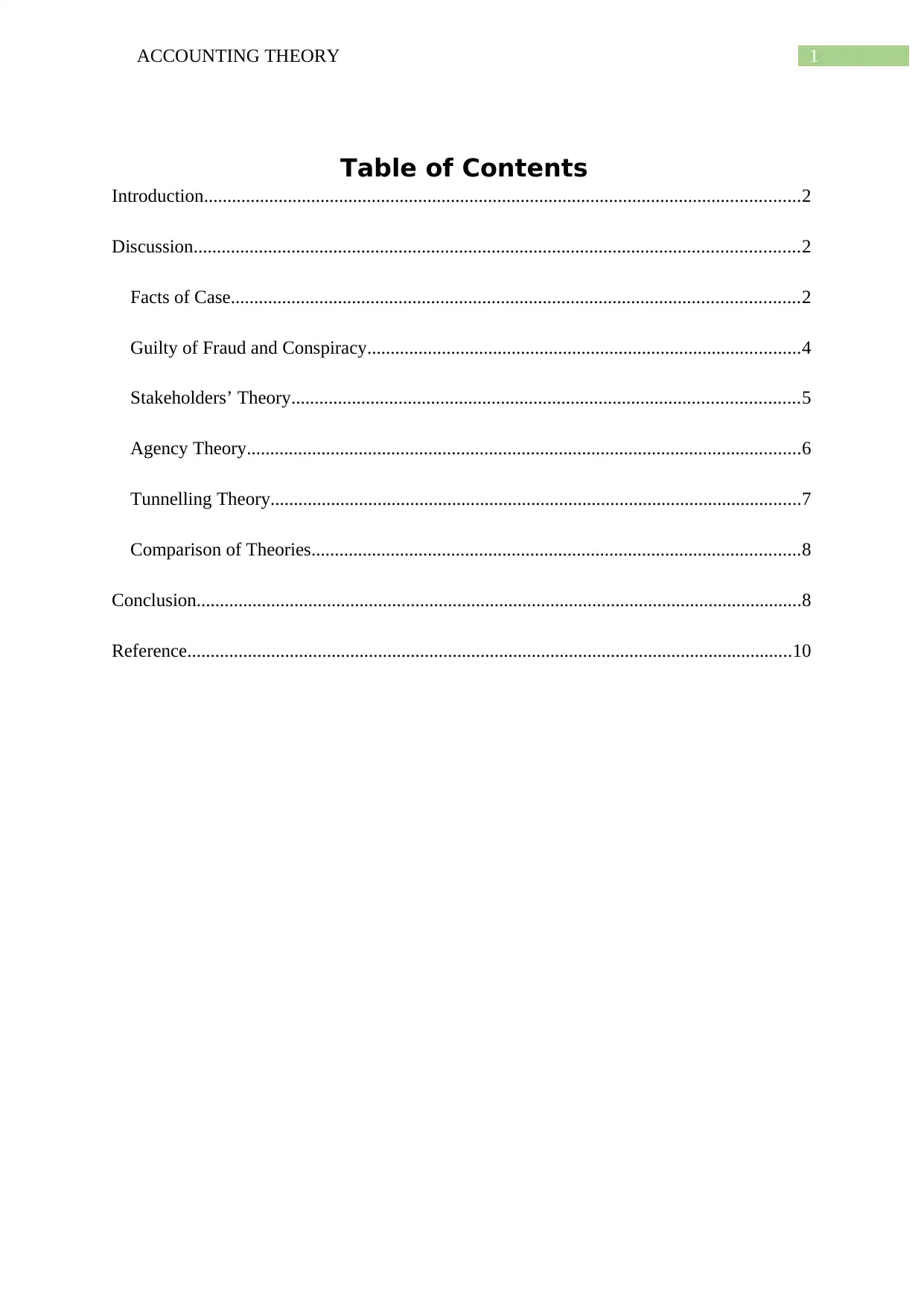
1ACCOUNTING THEORY
Table of Contents
Introduction................................................................................................................................2
Discussion..................................................................................................................................2
Facts of Case..........................................................................................................................2
Guilty of Fraud and Conspiracy.............................................................................................4
Stakeholders’ Theory.............................................................................................................5
Agency Theory.......................................................................................................................6
Tunnelling Theory..................................................................................................................7
Comparison of Theories.........................................................................................................8
Conclusion..................................................................................................................................8
Reference..................................................................................................................................10
Table of Contents
Introduction................................................................................................................................2
Discussion..................................................................................................................................2
Facts of Case..........................................................................................................................2
Guilty of Fraud and Conspiracy.............................................................................................4
Stakeholders’ Theory.............................................................................................................5
Agency Theory.......................................................................................................................6
Tunnelling Theory..................................................................................................................7
Comparison of Theories.........................................................................................................8
Conclusion..................................................................................................................................8
Reference..................................................................................................................................10
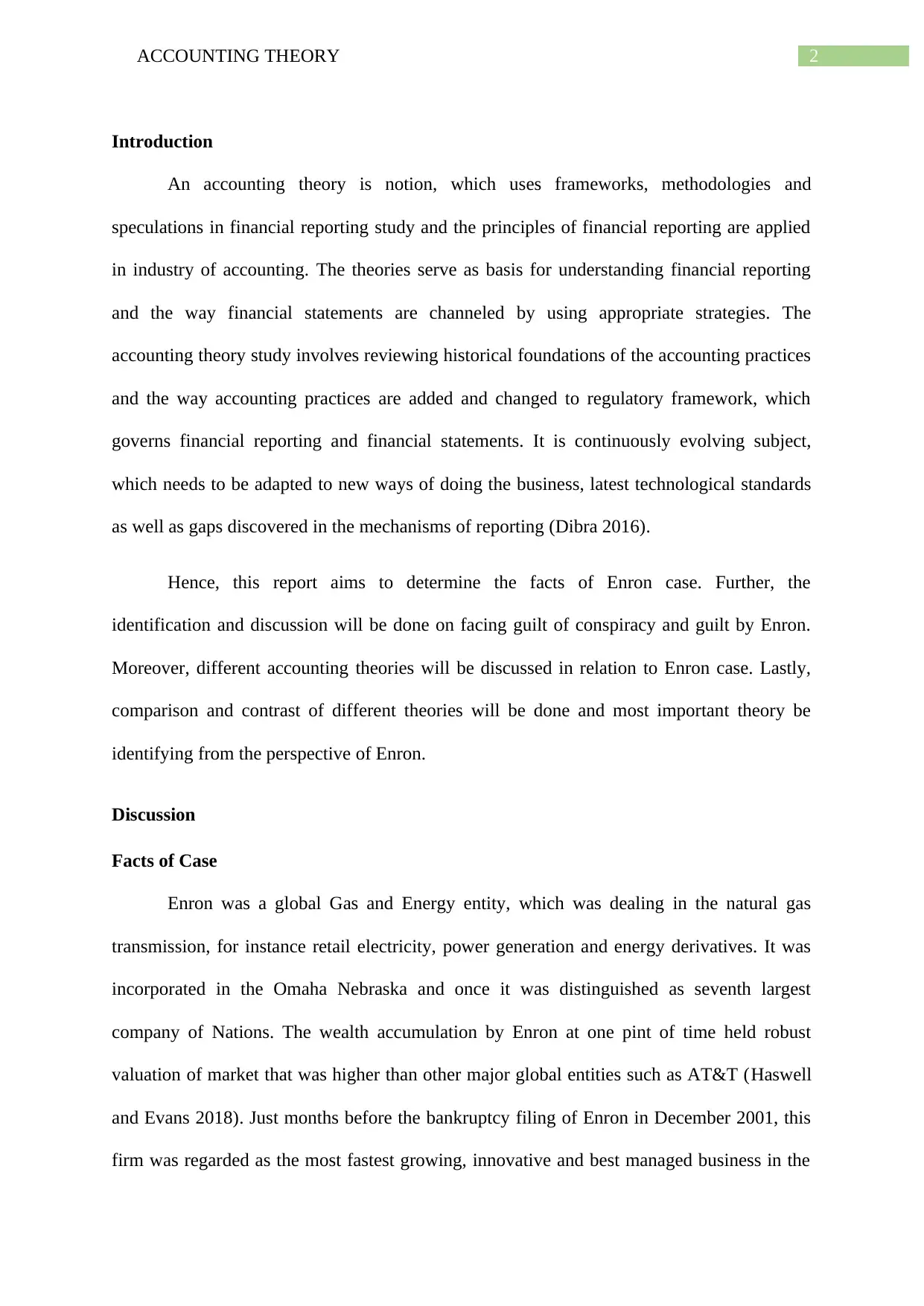
2ACCOUNTING THEORY
Introduction
An accounting theory is notion, which uses frameworks, methodologies and
speculations in financial reporting study and the principles of financial reporting are applied
in industry of accounting. The theories serve as basis for understanding financial reporting
and the way financial statements are channeled by using appropriate strategies. The
accounting theory study involves reviewing historical foundations of the accounting practices
and the way accounting practices are added and changed to regulatory framework, which
governs financial reporting and financial statements. It is continuously evolving subject,
which needs to be adapted to new ways of doing the business, latest technological standards
as well as gaps discovered in the mechanisms of reporting (Dibra 2016).
Hence, this report aims to determine the facts of Enron case. Further, the
identification and discussion will be done on facing guilt of conspiracy and guilt by Enron.
Moreover, different accounting theories will be discussed in relation to Enron case. Lastly,
comparison and contrast of different theories will be done and most important theory be
identifying from the perspective of Enron.
Discussion
Facts of Case
Enron was a global Gas and Energy entity, which was dealing in the natural gas
transmission, for instance retail electricity, power generation and energy derivatives. It was
incorporated in the Omaha Nebraska and once it was distinguished as seventh largest
company of Nations. The wealth accumulation by Enron at one pint of time held robust
valuation of market that was higher than other major global entities such as AT&T (Haswell
and Evans 2018). Just months before the bankruptcy filing of Enron in December 2001, this
firm was regarded as the most fastest growing, innovative and best managed business in the
Introduction
An accounting theory is notion, which uses frameworks, methodologies and
speculations in financial reporting study and the principles of financial reporting are applied
in industry of accounting. The theories serve as basis for understanding financial reporting
and the way financial statements are channeled by using appropriate strategies. The
accounting theory study involves reviewing historical foundations of the accounting practices
and the way accounting practices are added and changed to regulatory framework, which
governs financial reporting and financial statements. It is continuously evolving subject,
which needs to be adapted to new ways of doing the business, latest technological standards
as well as gaps discovered in the mechanisms of reporting (Dibra 2016).
Hence, this report aims to determine the facts of Enron case. Further, the
identification and discussion will be done on facing guilt of conspiracy and guilt by Enron.
Moreover, different accounting theories will be discussed in relation to Enron case. Lastly,
comparison and contrast of different theories will be done and most important theory be
identifying from the perspective of Enron.
Discussion
Facts of Case
Enron was a global Gas and Energy entity, which was dealing in the natural gas
transmission, for instance retail electricity, power generation and energy derivatives. It was
incorporated in the Omaha Nebraska and once it was distinguished as seventh largest
company of Nations. The wealth accumulation by Enron at one pint of time held robust
valuation of market that was higher than other major global entities such as AT&T (Haswell
and Evans 2018). Just months before the bankruptcy filing of Enron in December 2001, this
firm was regarded as the most fastest growing, innovative and best managed business in the
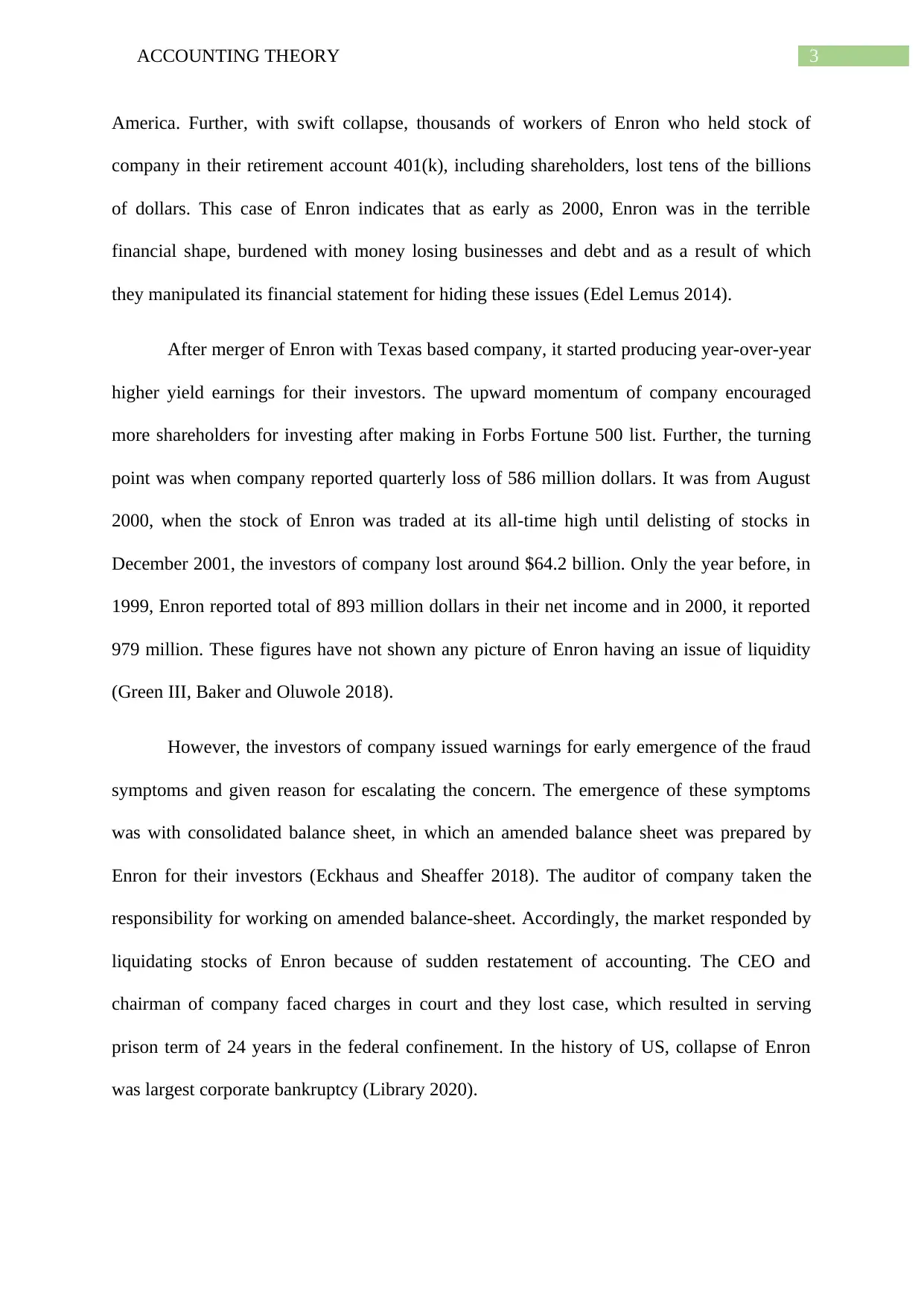
3ACCOUNTING THEORY
America. Further, with swift collapse, thousands of workers of Enron who held stock of
company in their retirement account 401(k), including shareholders, lost tens of the billions
of dollars. This case of Enron indicates that as early as 2000, Enron was in the terrible
financial shape, burdened with money losing businesses and debt and as a result of which
they manipulated its financial statement for hiding these issues (Edel Lemus 2014).
After merger of Enron with Texas based company, it started producing year-over-year
higher yield earnings for their investors. The upward momentum of company encouraged
more shareholders for investing after making in Forbs Fortune 500 list. Further, the turning
point was when company reported quarterly loss of 586 million dollars. It was from August
2000, when the stock of Enron was traded at its all-time high until delisting of stocks in
December 2001, the investors of company lost around $64.2 billion. Only the year before, in
1999, Enron reported total of 893 million dollars in their net income and in 2000, it reported
979 million. These figures have not shown any picture of Enron having an issue of liquidity
(Green III, Baker and Oluwole 2018).
However, the investors of company issued warnings for early emergence of the fraud
symptoms and given reason for escalating the concern. The emergence of these symptoms
was with consolidated balance sheet, in which an amended balance sheet was prepared by
Enron for their investors (Eckhaus and Sheaffer 2018). The auditor of company taken the
responsibility for working on amended balance-sheet. Accordingly, the market responded by
liquidating stocks of Enron because of sudden restatement of accounting. The CEO and
chairman of company faced charges in court and they lost case, which resulted in serving
prison term of 24 years in the federal confinement. In the history of US, collapse of Enron
was largest corporate bankruptcy (Library 2020).
America. Further, with swift collapse, thousands of workers of Enron who held stock of
company in their retirement account 401(k), including shareholders, lost tens of the billions
of dollars. This case of Enron indicates that as early as 2000, Enron was in the terrible
financial shape, burdened with money losing businesses and debt and as a result of which
they manipulated its financial statement for hiding these issues (Edel Lemus 2014).
After merger of Enron with Texas based company, it started producing year-over-year
higher yield earnings for their investors. The upward momentum of company encouraged
more shareholders for investing after making in Forbs Fortune 500 list. Further, the turning
point was when company reported quarterly loss of 586 million dollars. It was from August
2000, when the stock of Enron was traded at its all-time high until delisting of stocks in
December 2001, the investors of company lost around $64.2 billion. Only the year before, in
1999, Enron reported total of 893 million dollars in their net income and in 2000, it reported
979 million. These figures have not shown any picture of Enron having an issue of liquidity
(Green III, Baker and Oluwole 2018).
However, the investors of company issued warnings for early emergence of the fraud
symptoms and given reason for escalating the concern. The emergence of these symptoms
was with consolidated balance sheet, in which an amended balance sheet was prepared by
Enron for their investors (Eckhaus and Sheaffer 2018). The auditor of company taken the
responsibility for working on amended balance-sheet. Accordingly, the market responded by
liquidating stocks of Enron because of sudden restatement of accounting. The CEO and
chairman of company faced charges in court and they lost case, which resulted in serving
prison term of 24 years in the federal confinement. In the history of US, collapse of Enron
was largest corporate bankruptcy (Library 2020).
Secure Best Marks with AI Grader
Need help grading? Try our AI Grader for instant feedback on your assignments.
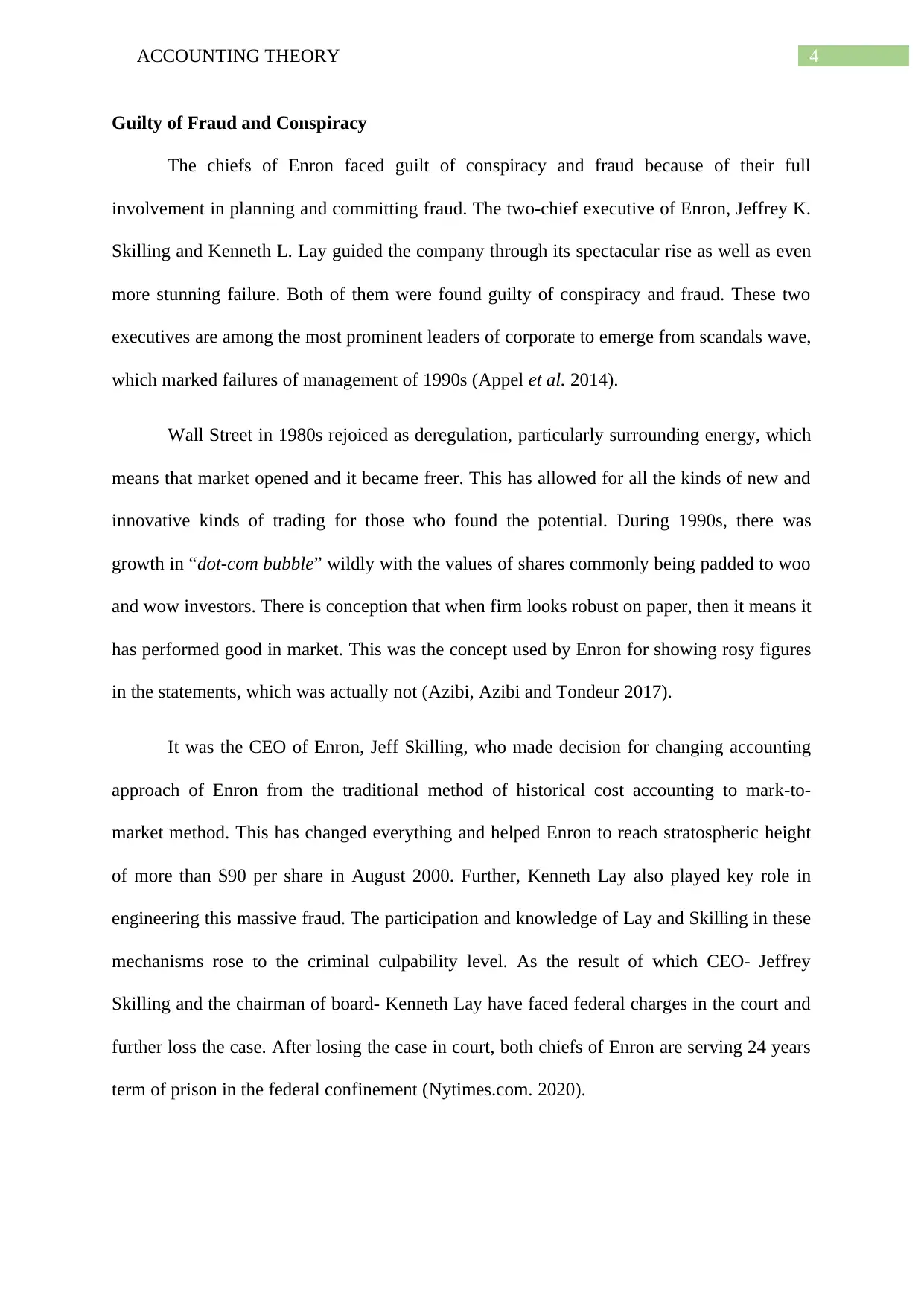
4ACCOUNTING THEORY
Guilty of Fraud and Conspiracy
The chiefs of Enron faced guilt of conspiracy and fraud because of their full
involvement in planning and committing fraud. The two-chief executive of Enron, Jeffrey K.
Skilling and Kenneth L. Lay guided the company through its spectacular rise as well as even
more stunning failure. Both of them were found guilty of conspiracy and fraud. These two
executives are among the most prominent leaders of corporate to emerge from scandals wave,
which marked failures of management of 1990s (Appel et al. 2014).
Wall Street in 1980s rejoiced as deregulation, particularly surrounding energy, which
means that market opened and it became freer. This has allowed for all the kinds of new and
innovative kinds of trading for those who found the potential. During 1990s, there was
growth in “dot-com bubble” wildly with the values of shares commonly being padded to woo
and wow investors. There is conception that when firm looks robust on paper, then it means it
has performed good in market. This was the concept used by Enron for showing rosy figures
in the statements, which was actually not (Azibi, Azibi and Tondeur 2017).
It was the CEO of Enron, Jeff Skilling, who made decision for changing accounting
approach of Enron from the traditional method of historical cost accounting to mark-to-
market method. This has changed everything and helped Enron to reach stratospheric height
of more than $90 per share in August 2000. Further, Kenneth Lay also played key role in
engineering this massive fraud. The participation and knowledge of Lay and Skilling in these
mechanisms rose to the criminal culpability level. As the result of which CEO- Jeffrey
Skilling and the chairman of board- Kenneth Lay have faced federal charges in the court and
further loss the case. After losing the case in court, both chiefs of Enron are serving 24 years
term of prison in the federal confinement (Nytimes.com. 2020).
Guilty of Fraud and Conspiracy
The chiefs of Enron faced guilt of conspiracy and fraud because of their full
involvement in planning and committing fraud. The two-chief executive of Enron, Jeffrey K.
Skilling and Kenneth L. Lay guided the company through its spectacular rise as well as even
more stunning failure. Both of them were found guilty of conspiracy and fraud. These two
executives are among the most prominent leaders of corporate to emerge from scandals wave,
which marked failures of management of 1990s (Appel et al. 2014).
Wall Street in 1980s rejoiced as deregulation, particularly surrounding energy, which
means that market opened and it became freer. This has allowed for all the kinds of new and
innovative kinds of trading for those who found the potential. During 1990s, there was
growth in “dot-com bubble” wildly with the values of shares commonly being padded to woo
and wow investors. There is conception that when firm looks robust on paper, then it means it
has performed good in market. This was the concept used by Enron for showing rosy figures
in the statements, which was actually not (Azibi, Azibi and Tondeur 2017).
It was the CEO of Enron, Jeff Skilling, who made decision for changing accounting
approach of Enron from the traditional method of historical cost accounting to mark-to-
market method. This has changed everything and helped Enron to reach stratospheric height
of more than $90 per share in August 2000. Further, Kenneth Lay also played key role in
engineering this massive fraud. The participation and knowledge of Lay and Skilling in these
mechanisms rose to the criminal culpability level. As the result of which CEO- Jeffrey
Skilling and the chairman of board- Kenneth Lay have faced federal charges in the court and
further loss the case. After losing the case in court, both chiefs of Enron are serving 24 years
term of prison in the federal confinement (Nytimes.com. 2020).
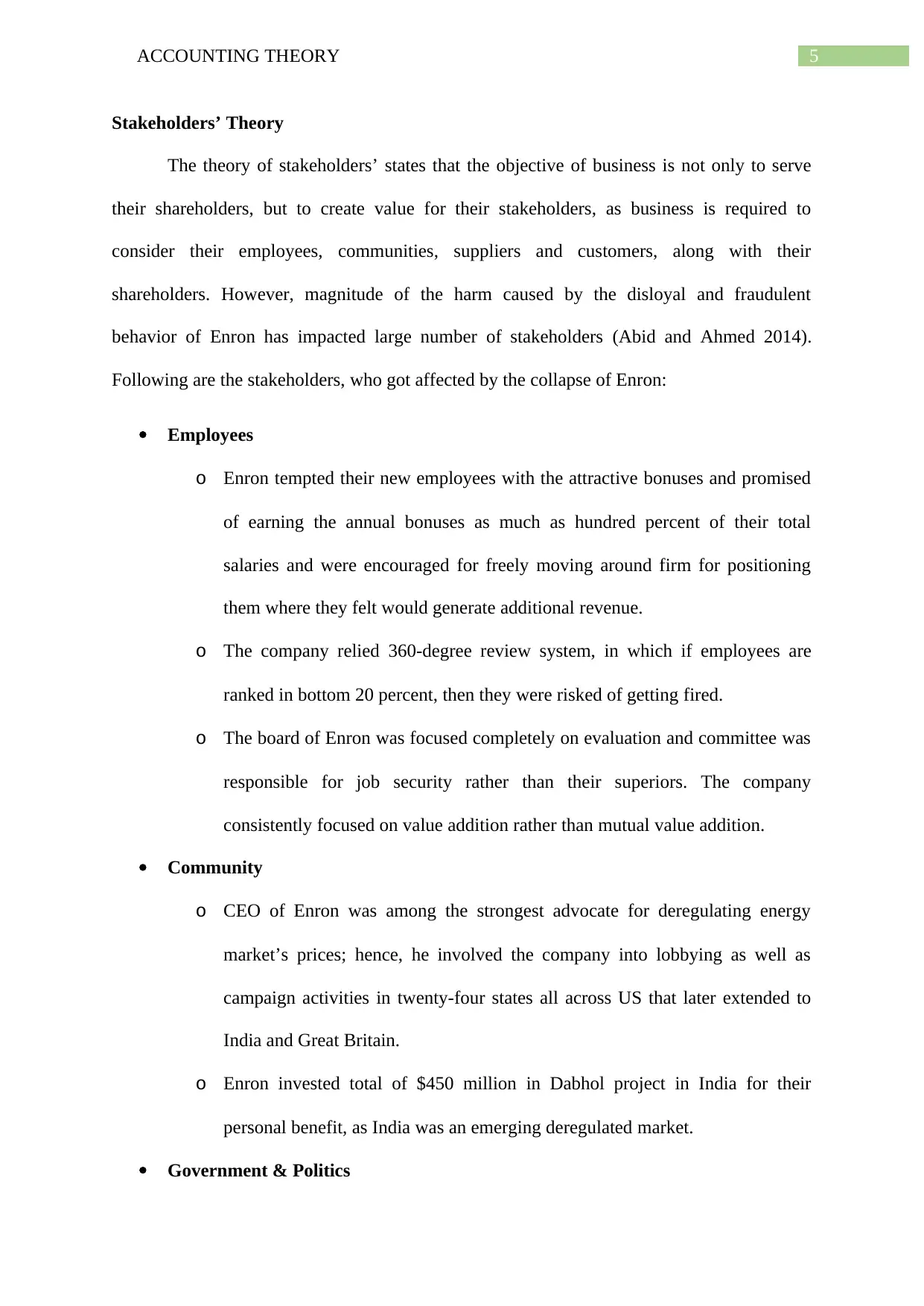
5ACCOUNTING THEORY
Stakeholders’ Theory
The theory of stakeholders’ states that the objective of business is not only to serve
their shareholders, but to create value for their stakeholders, as business is required to
consider their employees, communities, suppliers and customers, along with their
shareholders. However, magnitude of the harm caused by the disloyal and fraudulent
behavior of Enron has impacted large number of stakeholders (Abid and Ahmed 2014).
Following are the stakeholders, who got affected by the collapse of Enron:
Employees
o Enron tempted their new employees with the attractive bonuses and promised
of earning the annual bonuses as much as hundred percent of their total
salaries and were encouraged for freely moving around firm for positioning
them where they felt would generate additional revenue.
o The company relied 360-degree review system, in which if employees are
ranked in bottom 20 percent, then they were risked of getting fired.
o The board of Enron was focused completely on evaluation and committee was
responsible for job security rather than their superiors. The company
consistently focused on value addition rather than mutual value addition.
Community
o CEO of Enron was among the strongest advocate for deregulating energy
market’s prices; hence, he involved the company into lobbying as well as
campaign activities in twenty-four states all across US that later extended to
India and Great Britain.
o Enron invested total of $450 million in Dabhol project in India for their
personal benefit, as India was an emerging deregulated market.
Government & Politics
Stakeholders’ Theory
The theory of stakeholders’ states that the objective of business is not only to serve
their shareholders, but to create value for their stakeholders, as business is required to
consider their employees, communities, suppliers and customers, along with their
shareholders. However, magnitude of the harm caused by the disloyal and fraudulent
behavior of Enron has impacted large number of stakeholders (Abid and Ahmed 2014).
Following are the stakeholders, who got affected by the collapse of Enron:
Employees
o Enron tempted their new employees with the attractive bonuses and promised
of earning the annual bonuses as much as hundred percent of their total
salaries and were encouraged for freely moving around firm for positioning
them where they felt would generate additional revenue.
o The company relied 360-degree review system, in which if employees are
ranked in bottom 20 percent, then they were risked of getting fired.
o The board of Enron was focused completely on evaluation and committee was
responsible for job security rather than their superiors. The company
consistently focused on value addition rather than mutual value addition.
Community
o CEO of Enron was among the strongest advocate for deregulating energy
market’s prices; hence, he involved the company into lobbying as well as
campaign activities in twenty-four states all across US that later extended to
India and Great Britain.
o Enron invested total of $450 million in Dabhol project in India for their
personal benefit, as India was an emerging deregulated market.
Government & Politics
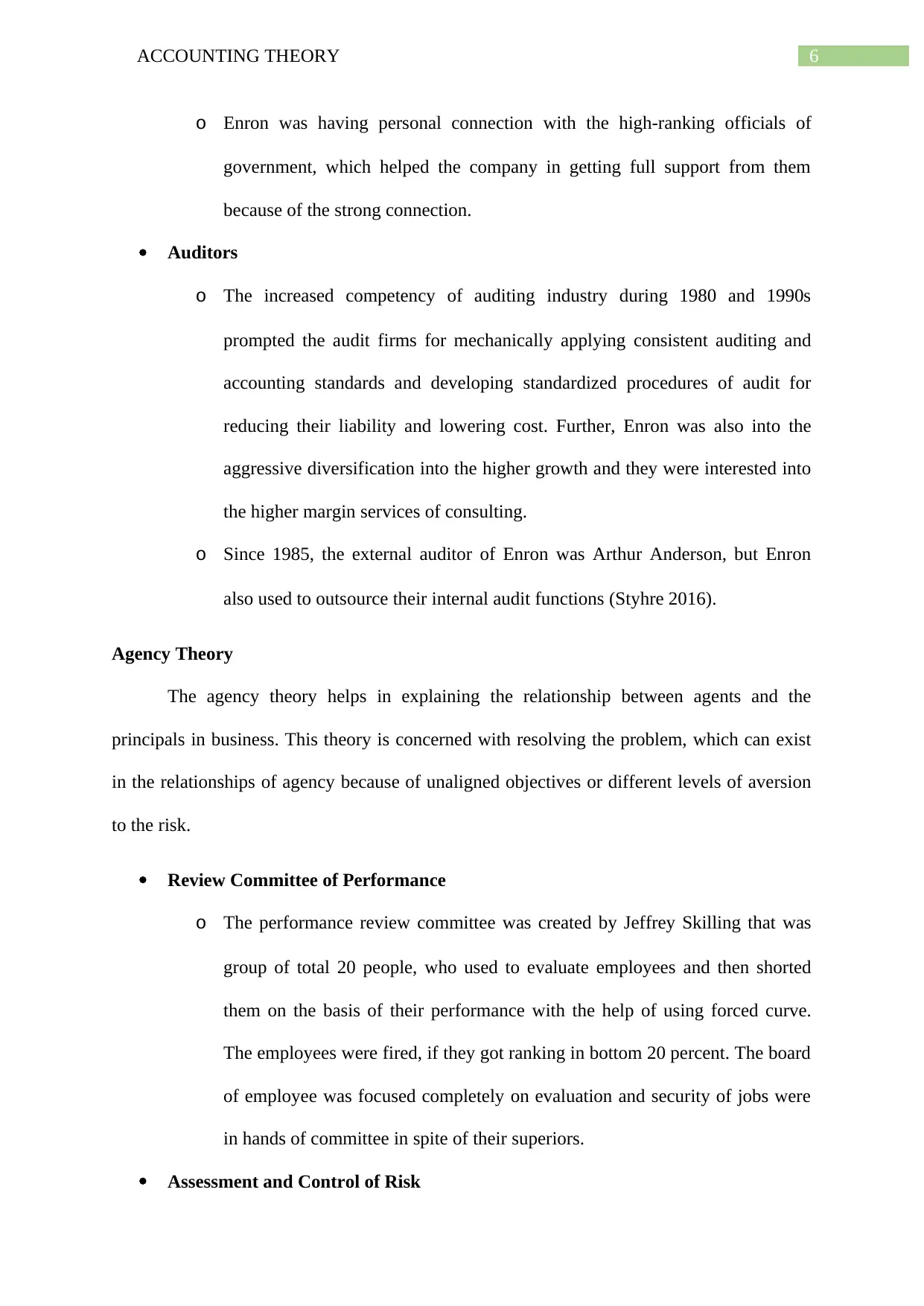
6ACCOUNTING THEORY
o Enron was having personal connection with the high-ranking officials of
government, which helped the company in getting full support from them
because of the strong connection.
Auditors
o The increased competency of auditing industry during 1980 and 1990s
prompted the audit firms for mechanically applying consistent auditing and
accounting standards and developing standardized procedures of audit for
reducing their liability and lowering cost. Further, Enron was also into the
aggressive diversification into the higher growth and they were interested into
the higher margin services of consulting.
o Since 1985, the external auditor of Enron was Arthur Anderson, but Enron
also used to outsource their internal audit functions (Styhre 2016).
Agency Theory
The agency theory helps in explaining the relationship between agents and the
principals in business. This theory is concerned with resolving the problem, which can exist
in the relationships of agency because of unaligned objectives or different levels of aversion
to the risk.
Review Committee of Performance
o The performance review committee was created by Jeffrey Skilling that was
group of total 20 people, who used to evaluate employees and then shorted
them on the basis of their performance with the help of using forced curve.
The employees were fired, if they got ranking in bottom 20 percent. The board
of employee was focused completely on evaluation and security of jobs were
in hands of committee in spite of their superiors.
Assessment and Control of Risk
o Enron was having personal connection with the high-ranking officials of
government, which helped the company in getting full support from them
because of the strong connection.
Auditors
o The increased competency of auditing industry during 1980 and 1990s
prompted the audit firms for mechanically applying consistent auditing and
accounting standards and developing standardized procedures of audit for
reducing their liability and lowering cost. Further, Enron was also into the
aggressive diversification into the higher growth and they were interested into
the higher margin services of consulting.
o Since 1985, the external auditor of Enron was Arthur Anderson, but Enron
also used to outsource their internal audit functions (Styhre 2016).
Agency Theory
The agency theory helps in explaining the relationship between agents and the
principals in business. This theory is concerned with resolving the problem, which can exist
in the relationships of agency because of unaligned objectives or different levels of aversion
to the risk.
Review Committee of Performance
o The performance review committee was created by Jeffrey Skilling that was
group of total 20 people, who used to evaluate employees and then shorted
them on the basis of their performance with the help of using forced curve.
The employees were fired, if they got ranking in bottom 20 percent. The board
of employee was focused completely on evaluation and security of jobs were
in hands of committee in spite of their superiors.
Assessment and Control of Risk
Paraphrase This Document
Need a fresh take? Get an instant paraphrase of this document with our AI Paraphraser
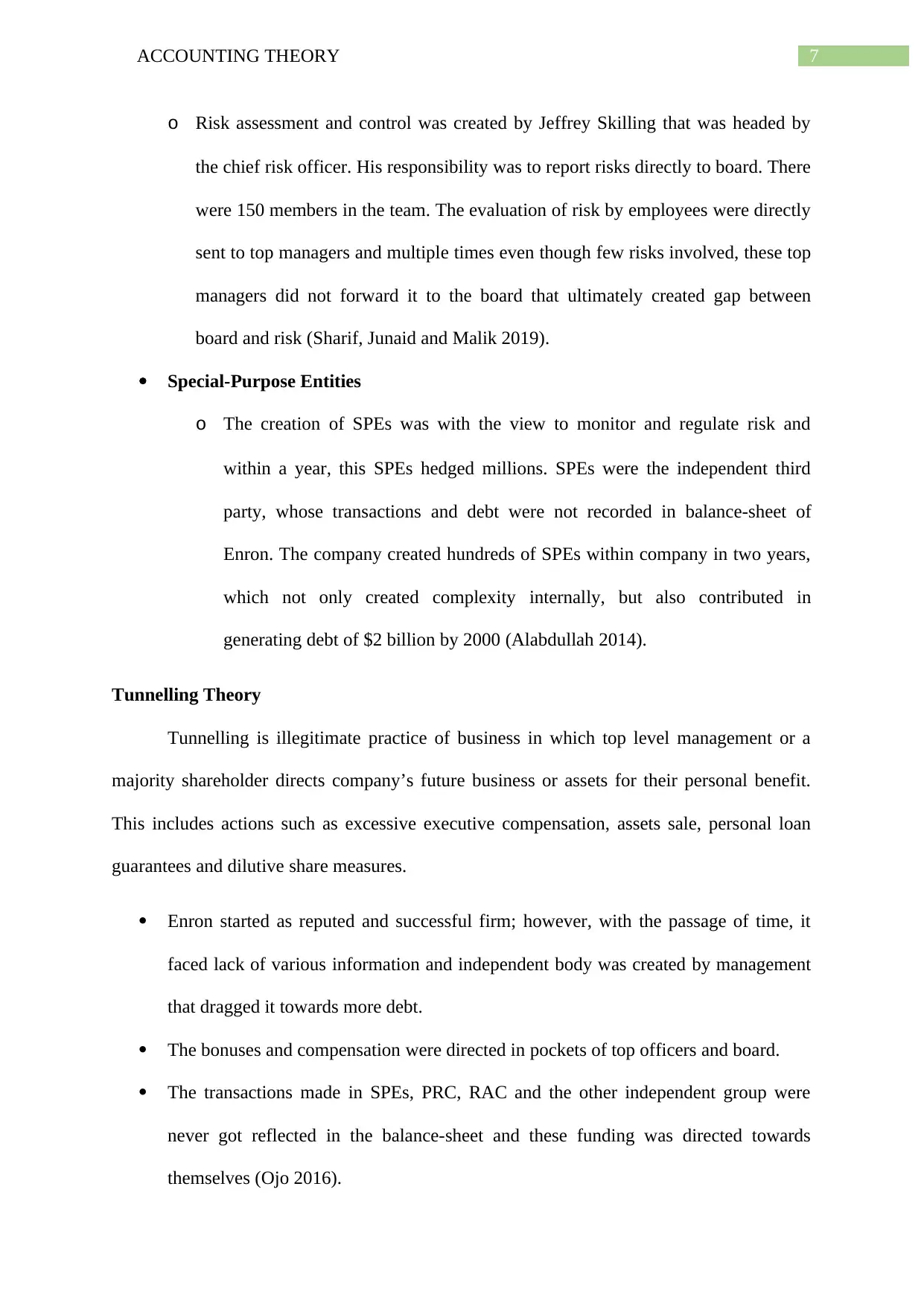
7ACCOUNTING THEORY
o Risk assessment and control was created by Jeffrey Skilling that was headed by
the chief risk officer. His responsibility was to report risks directly to board. There
were 150 members in the team. The evaluation of risk by employees were directly
sent to top managers and multiple times even though few risks involved, these top
managers did not forward it to the board that ultimately created gap between
board and risk (Sharif, Junaid and Malik 2019).
Special-Purpose Entities
o The creation of SPEs was with the view to monitor and regulate risk and
within a year, this SPEs hedged millions. SPEs were the independent third
party, whose transactions and debt were not recorded in balance-sheet of
Enron. The company created hundreds of SPEs within company in two years,
which not only created complexity internally, but also contributed in
generating debt of $2 billion by 2000 (Alabdullah 2014).
Tunnelling Theory
Tunnelling is illegitimate practice of business in which top level management or a
majority shareholder directs company’s future business or assets for their personal benefit.
This includes actions such as excessive executive compensation, assets sale, personal loan
guarantees and dilutive share measures.
Enron started as reputed and successful firm; however, with the passage of time, it
faced lack of various information and independent body was created by management
that dragged it towards more debt.
The bonuses and compensation were directed in pockets of top officers and board.
The transactions made in SPEs, PRC, RAC and the other independent group were
never got reflected in the balance-sheet and these funding was directed towards
themselves (Ojo 2016).
o Risk assessment and control was created by Jeffrey Skilling that was headed by
the chief risk officer. His responsibility was to report risks directly to board. There
were 150 members in the team. The evaluation of risk by employees were directly
sent to top managers and multiple times even though few risks involved, these top
managers did not forward it to the board that ultimately created gap between
board and risk (Sharif, Junaid and Malik 2019).
Special-Purpose Entities
o The creation of SPEs was with the view to monitor and regulate risk and
within a year, this SPEs hedged millions. SPEs were the independent third
party, whose transactions and debt were not recorded in balance-sheet of
Enron. The company created hundreds of SPEs within company in two years,
which not only created complexity internally, but also contributed in
generating debt of $2 billion by 2000 (Alabdullah 2014).
Tunnelling Theory
Tunnelling is illegitimate practice of business in which top level management or a
majority shareholder directs company’s future business or assets for their personal benefit.
This includes actions such as excessive executive compensation, assets sale, personal loan
guarantees and dilutive share measures.
Enron started as reputed and successful firm; however, with the passage of time, it
faced lack of various information and independent body was created by management
that dragged it towards more debt.
The bonuses and compensation were directed in pockets of top officers and board.
The transactions made in SPEs, PRC, RAC and the other independent group were
never got reflected in the balance-sheet and these funding was directed towards
themselves (Ojo 2016).
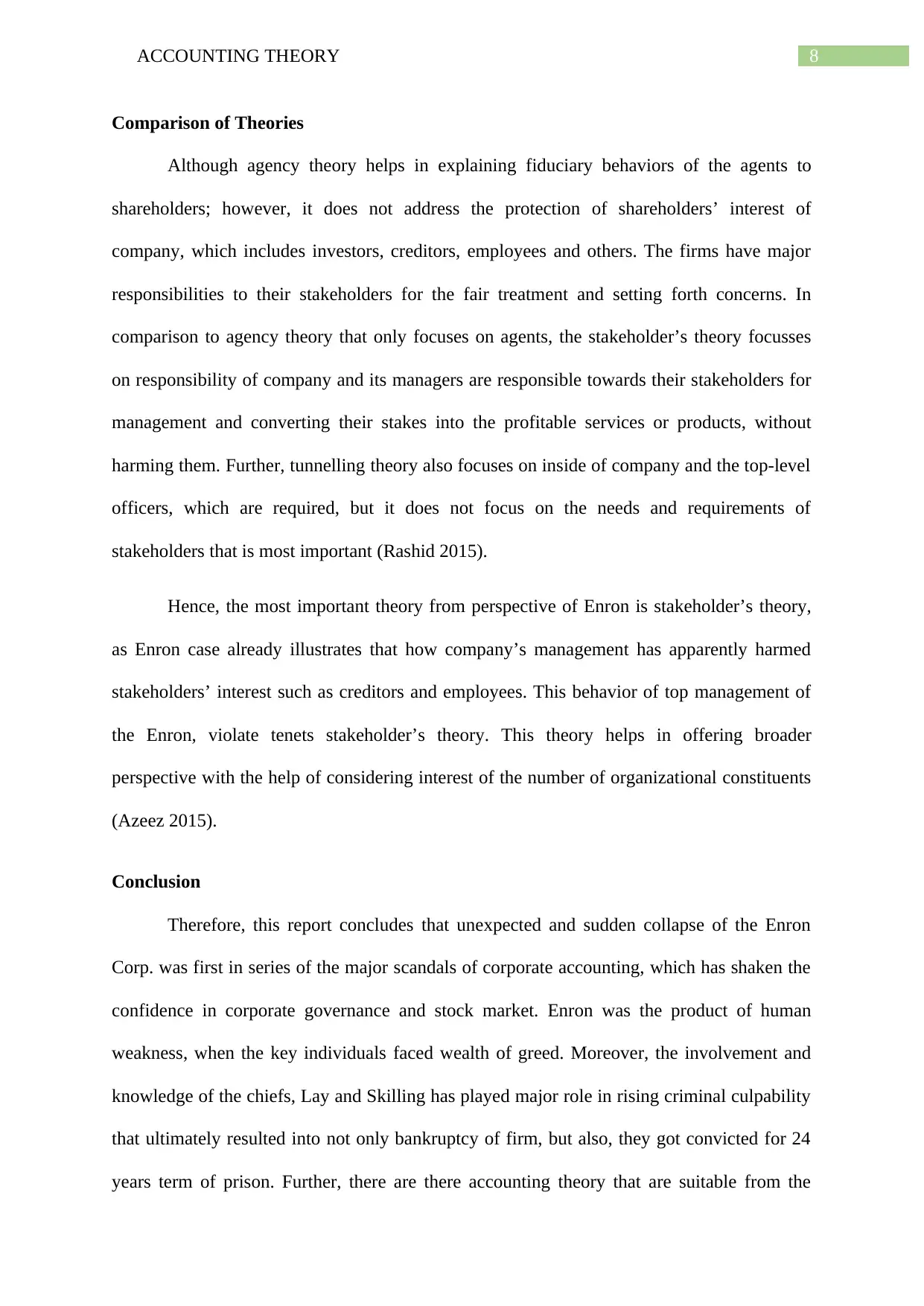
8ACCOUNTING THEORY
Comparison of Theories
Although agency theory helps in explaining fiduciary behaviors of the agents to
shareholders; however, it does not address the protection of shareholders’ interest of
company, which includes investors, creditors, employees and others. The firms have major
responsibilities to their stakeholders for the fair treatment and setting forth concerns. In
comparison to agency theory that only focuses on agents, the stakeholder’s theory focusses
on responsibility of company and its managers are responsible towards their stakeholders for
management and converting their stakes into the profitable services or products, without
harming them. Further, tunnelling theory also focuses on inside of company and the top-level
officers, which are required, but it does not focus on the needs and requirements of
stakeholders that is most important (Rashid 2015).
Hence, the most important theory from perspective of Enron is stakeholder’s theory,
as Enron case already illustrates that how company’s management has apparently harmed
stakeholders’ interest such as creditors and employees. This behavior of top management of
the Enron, violate tenets stakeholder’s theory. This theory helps in offering broader
perspective with the help of considering interest of the number of organizational constituents
(Azeez 2015).
Conclusion
Therefore, this report concludes that unexpected and sudden collapse of the Enron
Corp. was first in series of the major scandals of corporate accounting, which has shaken the
confidence in corporate governance and stock market. Enron was the product of human
weakness, when the key individuals faced wealth of greed. Moreover, the involvement and
knowledge of the chiefs, Lay and Skilling has played major role in rising criminal culpability
that ultimately resulted into not only bankruptcy of firm, but also, they got convicted for 24
years term of prison. Further, there are there accounting theory that are suitable from the
Comparison of Theories
Although agency theory helps in explaining fiduciary behaviors of the agents to
shareholders; however, it does not address the protection of shareholders’ interest of
company, which includes investors, creditors, employees and others. The firms have major
responsibilities to their stakeholders for the fair treatment and setting forth concerns. In
comparison to agency theory that only focuses on agents, the stakeholder’s theory focusses
on responsibility of company and its managers are responsible towards their stakeholders for
management and converting their stakes into the profitable services or products, without
harming them. Further, tunnelling theory also focuses on inside of company and the top-level
officers, which are required, but it does not focus on the needs and requirements of
stakeholders that is most important (Rashid 2015).
Hence, the most important theory from perspective of Enron is stakeholder’s theory,
as Enron case already illustrates that how company’s management has apparently harmed
stakeholders’ interest such as creditors and employees. This behavior of top management of
the Enron, violate tenets stakeholder’s theory. This theory helps in offering broader
perspective with the help of considering interest of the number of organizational constituents
(Azeez 2015).
Conclusion
Therefore, this report concludes that unexpected and sudden collapse of the Enron
Corp. was first in series of the major scandals of corporate accounting, which has shaken the
confidence in corporate governance and stock market. Enron was the product of human
weakness, when the key individuals faced wealth of greed. Moreover, the involvement and
knowledge of the chiefs, Lay and Skilling has played major role in rising criminal culpability
that ultimately resulted into not only bankruptcy of firm, but also, they got convicted for 24
years term of prison. Further, there are there accounting theory that are suitable from the
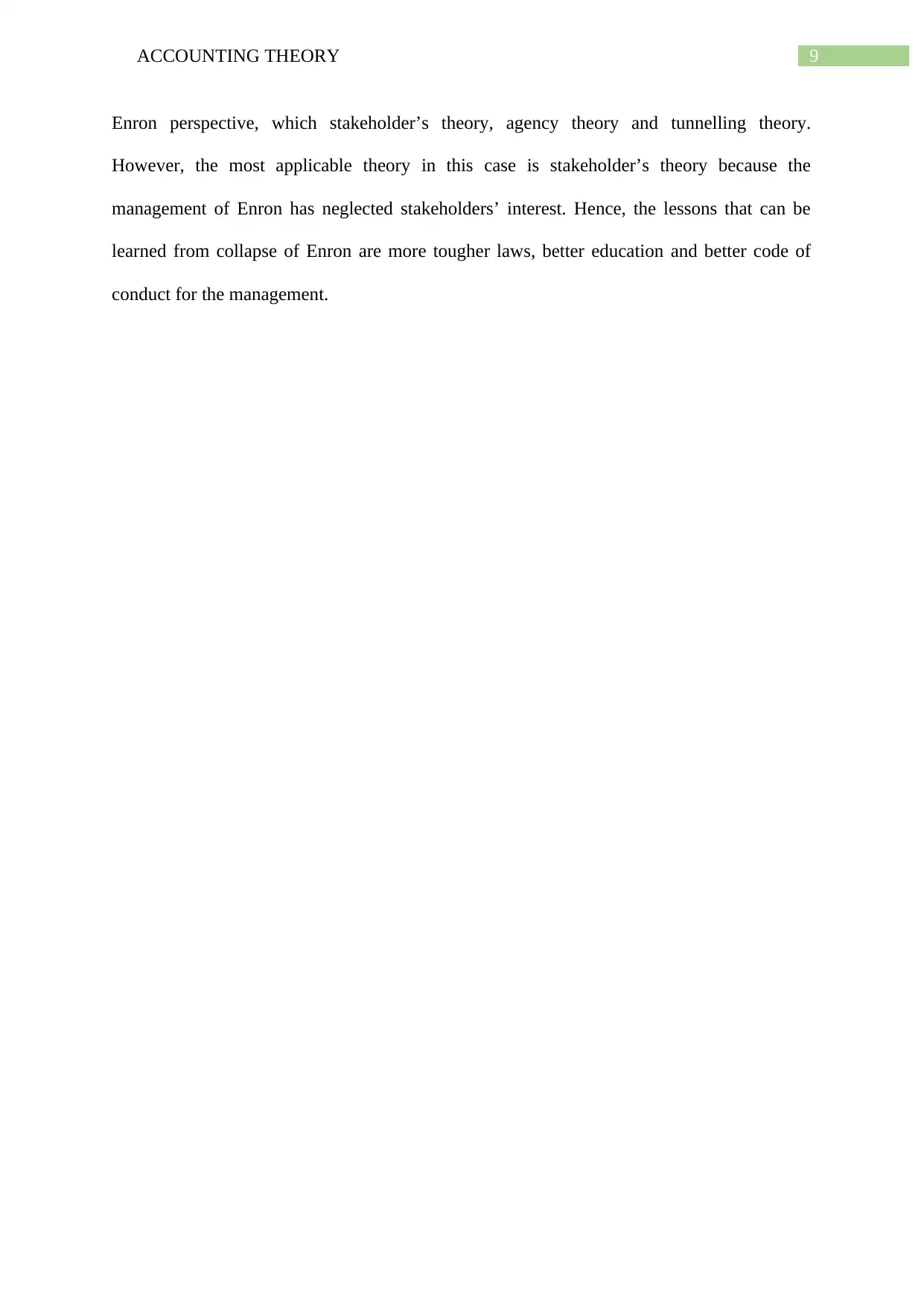
9ACCOUNTING THEORY
Enron perspective, which stakeholder’s theory, agency theory and tunnelling theory.
However, the most applicable theory in this case is stakeholder’s theory because the
management of Enron has neglected stakeholders’ interest. Hence, the lessons that can be
learned from collapse of Enron are more tougher laws, better education and better code of
conduct for the management.
Enron perspective, which stakeholder’s theory, agency theory and tunnelling theory.
However, the most applicable theory in this case is stakeholder’s theory because the
management of Enron has neglected stakeholders’ interest. Hence, the lessons that can be
learned from collapse of Enron are more tougher laws, better education and better code of
conduct for the management.
Secure Best Marks with AI Grader
Need help grading? Try our AI Grader for instant feedback on your assignments.
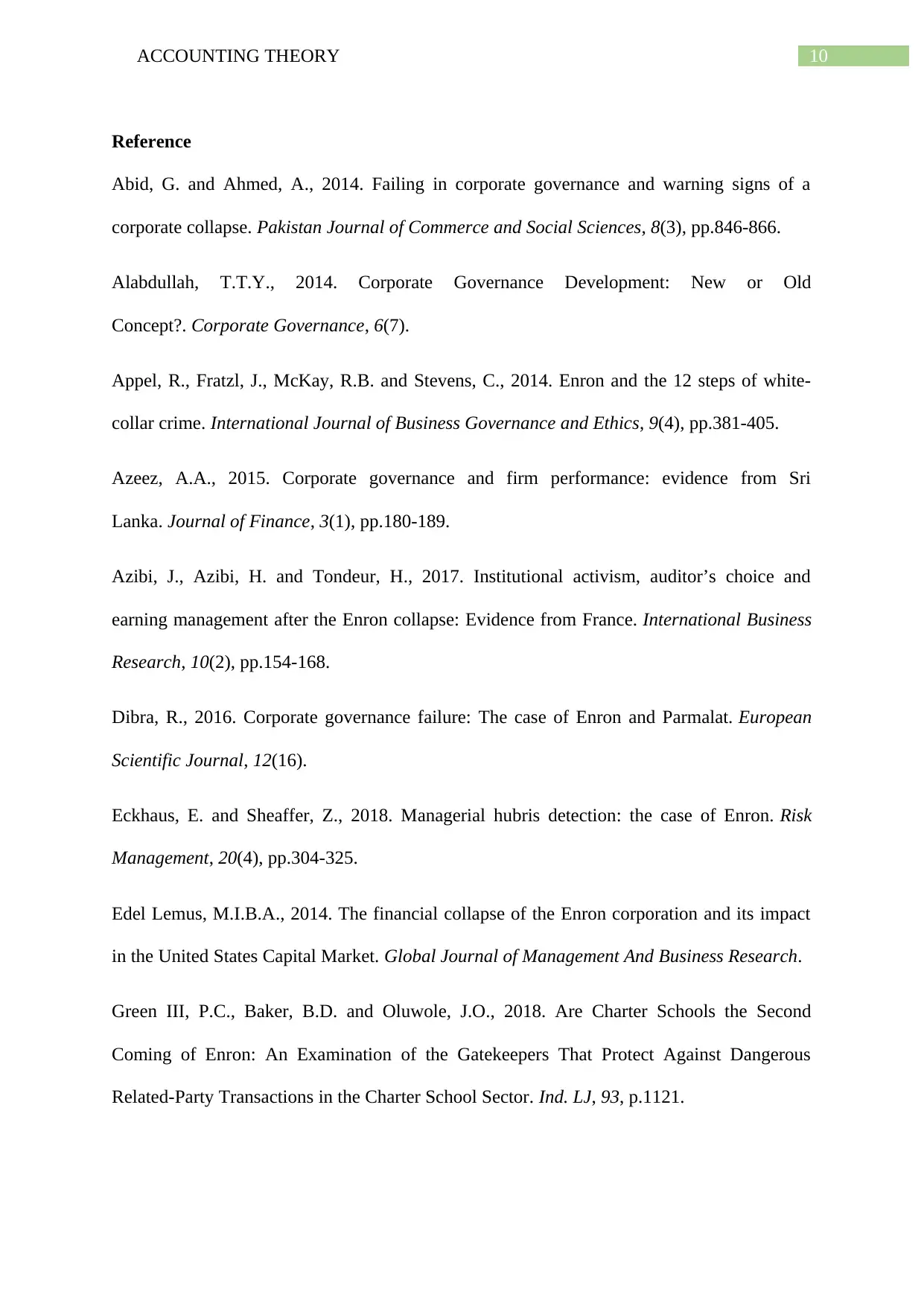
10ACCOUNTING THEORY
Reference
Abid, G. and Ahmed, A., 2014. Failing in corporate governance and warning signs of a
corporate collapse. Pakistan Journal of Commerce and Social Sciences, 8(3), pp.846-866.
Alabdullah, T.T.Y., 2014. Corporate Governance Development: New or Old
Concept?. Corporate Governance, 6(7).
Appel, R., Fratzl, J., McKay, R.B. and Stevens, C., 2014. Enron and the 12 steps of white-
collar crime. International Journal of Business Governance and Ethics, 9(4), pp.381-405.
Azeez, A.A., 2015. Corporate governance and firm performance: evidence from Sri
Lanka. Journal of Finance, 3(1), pp.180-189.
Azibi, J., Azibi, H. and Tondeur, H., 2017. Institutional activism, auditor’s choice and
earning management after the Enron collapse: Evidence from France. International Business
Research, 10(2), pp.154-168.
Dibra, R., 2016. Corporate governance failure: The case of Enron and Parmalat. European
Scientific Journal, 12(16).
Eckhaus, E. and Sheaffer, Z., 2018. Managerial hubris detection: the case of Enron. Risk
Management, 20(4), pp.304-325.
Edel Lemus, M.I.B.A., 2014. The financial collapse of the Enron corporation and its impact
in the United States Capital Market. Global Journal of Management And Business Research.
Green III, P.C., Baker, B.D. and Oluwole, J.O., 2018. Are Charter Schools the Second
Coming of Enron: An Examination of the Gatekeepers That Protect Against Dangerous
Related-Party Transactions in the Charter School Sector. Ind. LJ, 93, p.1121.
Reference
Abid, G. and Ahmed, A., 2014. Failing in corporate governance and warning signs of a
corporate collapse. Pakistan Journal of Commerce and Social Sciences, 8(3), pp.846-866.
Alabdullah, T.T.Y., 2014. Corporate Governance Development: New or Old
Concept?. Corporate Governance, 6(7).
Appel, R., Fratzl, J., McKay, R.B. and Stevens, C., 2014. Enron and the 12 steps of white-
collar crime. International Journal of Business Governance and Ethics, 9(4), pp.381-405.
Azeez, A.A., 2015. Corporate governance and firm performance: evidence from Sri
Lanka. Journal of Finance, 3(1), pp.180-189.
Azibi, J., Azibi, H. and Tondeur, H., 2017. Institutional activism, auditor’s choice and
earning management after the Enron collapse: Evidence from France. International Business
Research, 10(2), pp.154-168.
Dibra, R., 2016. Corporate governance failure: The case of Enron and Parmalat. European
Scientific Journal, 12(16).
Eckhaus, E. and Sheaffer, Z., 2018. Managerial hubris detection: the case of Enron. Risk
Management, 20(4), pp.304-325.
Edel Lemus, M.I.B.A., 2014. The financial collapse of the Enron corporation and its impact
in the United States Capital Market. Global Journal of Management And Business Research.
Green III, P.C., Baker, B.D. and Oluwole, J.O., 2018. Are Charter Schools the Second
Coming of Enron: An Examination of the Gatekeepers That Protect Against Dangerous
Related-Party Transactions in the Charter School Sector. Ind. LJ, 93, p.1121.
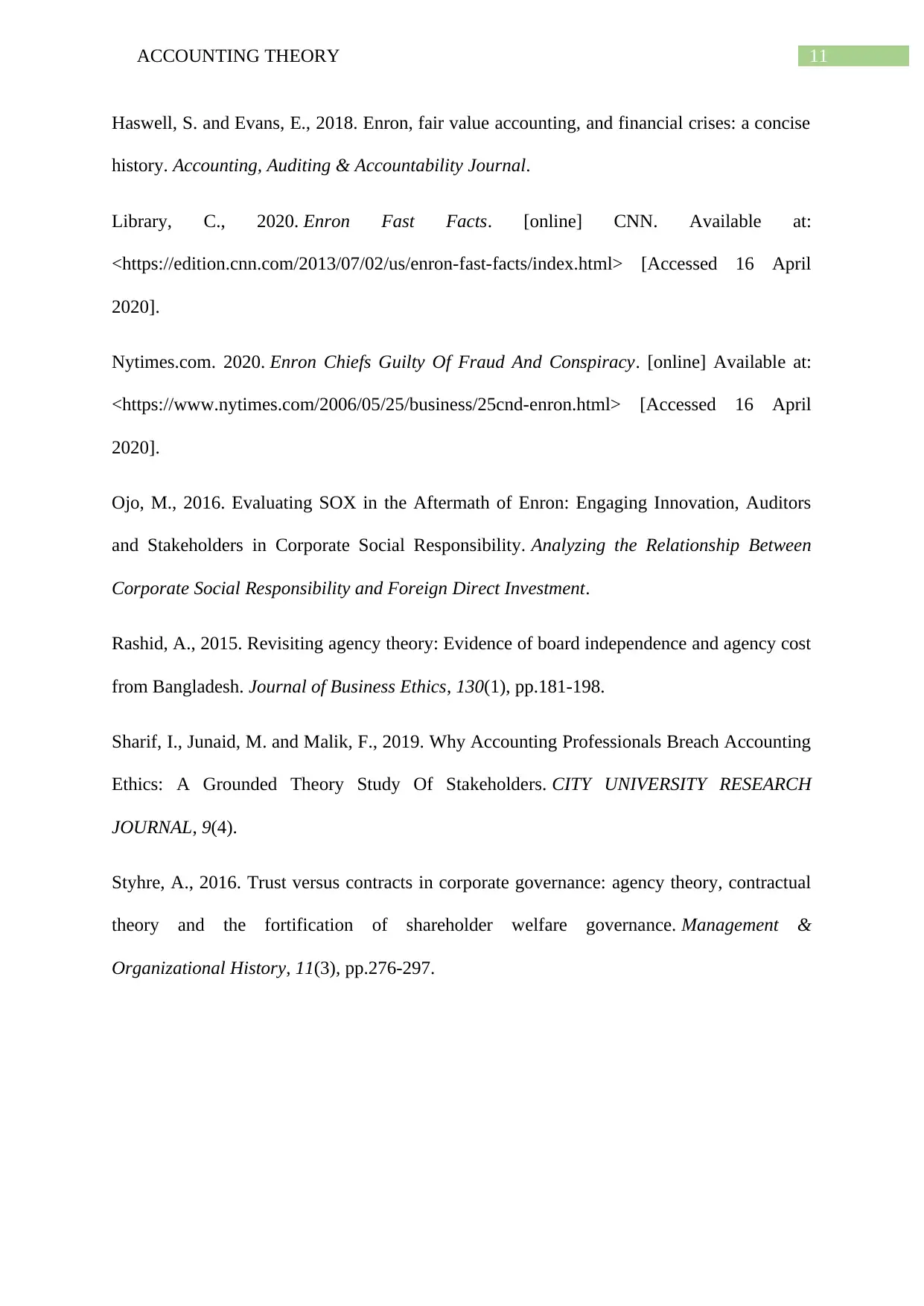
11ACCOUNTING THEORY
Haswell, S. and Evans, E., 2018. Enron, fair value accounting, and financial crises: a concise
history. Accounting, Auditing & Accountability Journal.
Library, C., 2020. Enron Fast Facts. [online] CNN. Available at:
<https://edition.cnn.com/2013/07/02/us/enron-fast-facts/index.html> [Accessed 16 April
2020].
Nytimes.com. 2020. Enron Chiefs Guilty Of Fraud And Conspiracy. [online] Available at:
<https://www.nytimes.com/2006/05/25/business/25cnd-enron.html> [Accessed 16 April
2020].
Ojo, M., 2016. Evaluating SOX in the Aftermath of Enron: Engaging Innovation, Auditors
and Stakeholders in Corporate Social Responsibility. Analyzing the Relationship Between
Corporate Social Responsibility and Foreign Direct Investment.
Rashid, A., 2015. Revisiting agency theory: Evidence of board independence and agency cost
from Bangladesh. Journal of Business Ethics, 130(1), pp.181-198.
Sharif, I., Junaid, M. and Malik, F., 2019. Why Accounting Professionals Breach Accounting
Ethics: A Grounded Theory Study Of Stakeholders. CITY UNIVERSITY RESEARCH
JOURNAL, 9(4).
Styhre, A., 2016. Trust versus contracts in corporate governance: agency theory, contractual
theory and the fortification of shareholder welfare governance. Management &
Organizational History, 11(3), pp.276-297.
Haswell, S. and Evans, E., 2018. Enron, fair value accounting, and financial crises: a concise
history. Accounting, Auditing & Accountability Journal.
Library, C., 2020. Enron Fast Facts. [online] CNN. Available at:
<https://edition.cnn.com/2013/07/02/us/enron-fast-facts/index.html> [Accessed 16 April
2020].
Nytimes.com. 2020. Enron Chiefs Guilty Of Fraud And Conspiracy. [online] Available at:
<https://www.nytimes.com/2006/05/25/business/25cnd-enron.html> [Accessed 16 April
2020].
Ojo, M., 2016. Evaluating SOX in the Aftermath of Enron: Engaging Innovation, Auditors
and Stakeholders in Corporate Social Responsibility. Analyzing the Relationship Between
Corporate Social Responsibility and Foreign Direct Investment.
Rashid, A., 2015. Revisiting agency theory: Evidence of board independence and agency cost
from Bangladesh. Journal of Business Ethics, 130(1), pp.181-198.
Sharif, I., Junaid, M. and Malik, F., 2019. Why Accounting Professionals Breach Accounting
Ethics: A Grounded Theory Study Of Stakeholders. CITY UNIVERSITY RESEARCH
JOURNAL, 9(4).
Styhre, A., 2016. Trust versus contracts in corporate governance: agency theory, contractual
theory and the fortification of shareholder welfare governance. Management &
Organizational History, 11(3), pp.276-297.
1 out of 12
Related Documents
Your All-in-One AI-Powered Toolkit for Academic Success.
+13062052269
info@desklib.com
Available 24*7 on WhatsApp / Email
![[object Object]](/_next/static/media/star-bottom.7253800d.svg)
Unlock your academic potential
© 2024 | Zucol Services PVT LTD | All rights reserved.





